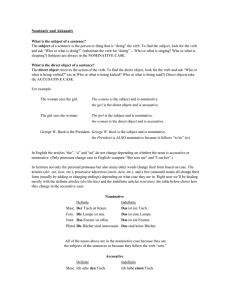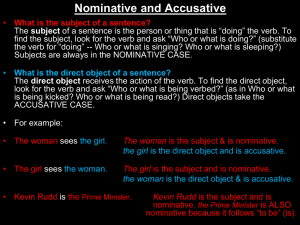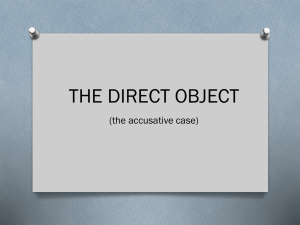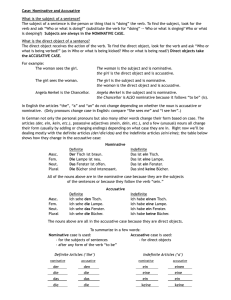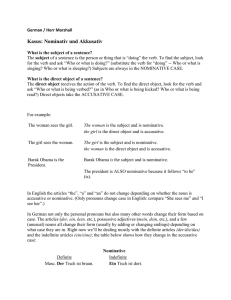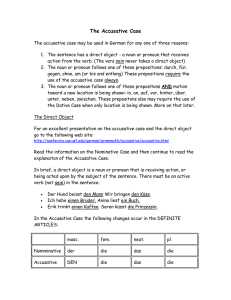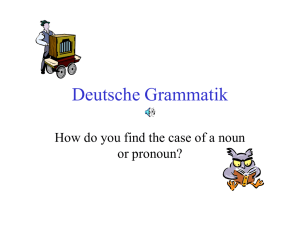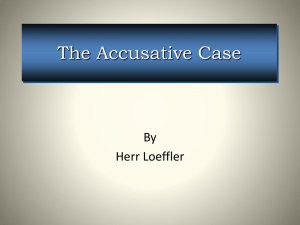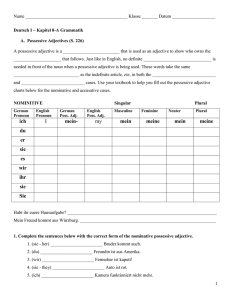German1A Packet 2D Name: Handout: Nominativ und Akkusativ
Werbung
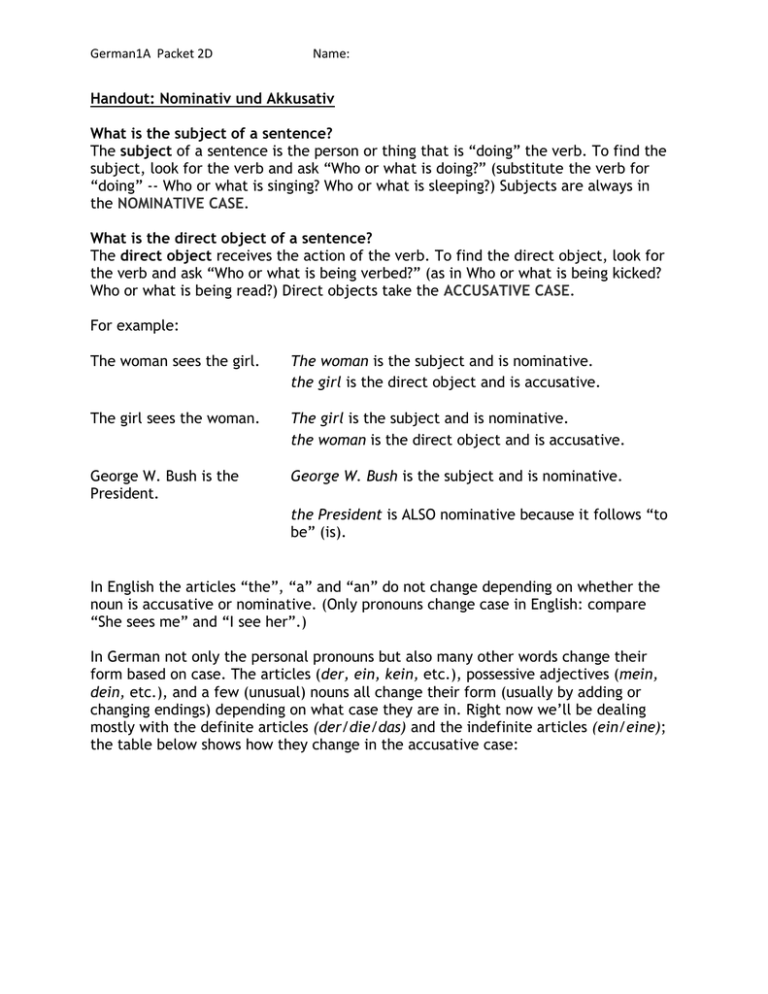
German1A Packet 2D Name: Handout: Nominativ und Akkusativ What is the subject of a sentence? The subject of a sentence is the person or thing that is “doing” the verb. To find the subject, look for the verb and ask “Who or what is doing?” (substitute the verb for “doing” -- Who or what is singing? Who or what is sleeping?) Subjects are always in the NOMINATIVE CASE. What is the direct object of a sentence? The direct object receives the action of the verb. To find the direct object, look for the verb and ask “Who or what is being verbed?” (as in Who or what is being kicked? Who or what is being read?) Direct objects take the ACCUSATIVE CASE. For example: The woman sees the girl. The woman is the subject and is nominative. the girl is the direct object and is accusative. The girl sees the woman. The girl is the subject and is nominative. the woman is the direct object and is accusative. George W. Bush is the President. George W. Bush is the subject and is nominative. the President is ALSO nominative because it follows “to be” (is). In English the articles “the”, “a” and “an” do not change depending on whether the noun is accusative or nominative. (Only pronouns change case in English: compare “She sees me” and “I see her”.) In German not only the personal pronouns but also many other words change their form based on case. The articles (der, ein, kein, etc.), possessive adjectives (mein, dein, etc.), and a few (unusual) nouns all change their form (usually by adding or changing endings) depending on what case they are in. Right now we’ll be dealing mostly with the definite articles (der/die/das) and the indefinite articles (ein/eine); the table below shows how they change in the accusative case: German1A Packet 2D Name: TRANSLATE Nominative Definite Indefinite Masc. Der Tisch ist braun. Das ist ein Tisch. The desk is braun. That is a desk. Fem. Die Lampe ist neu. Das ist eine Lampe. Neut. Das Fenster ist offen. Das ist ein Fenster. Plural Die Bücher sind interessant. Das sind keine Bücher. All of the nouns above are in the nominative case because they are the subjects of the sentences or because they follow the verb “sein.” TRANSLATE Accusative Definite Indefinite Masc. Ich sehe den Tisch. Ich habe einen Tisch. I see the desk. I have a desk. Fem. Ich sehe die Lampe. Ich habe eine Lampe. Neut. Ich sehe das Fenster. Ich habe ein Fenster. Plural Ich sehe die Bücher. Ich habe keine Bücher. The nouns above are all in the accusative case because they are direct objects. German1A Packet 2D Name: To summarize in a few words: Nominative case is used: Accusative case is used: - for the subjects of sentences - for direct objects - after any form of the verb “to be” - after accusative prepositions A. Practice. Circle all nouns in the nominative, and underline all nouns in the accusative. 1. I meet them on Tuesday. 6. He plays the piano. 2. They invited me. 7. Run Lola Run is a German movie. 3. Paul hit the ball. 8. I’m sleeping. 4. Martin and Petra like to read. 9. Is that a Mercedes? 5. Have you seen a Shakespeare play? 10. Donald owns a hotel and a car. B. Auf deutsch. Now practice identifying subjects and objects in these German sentences. 1. Er hat ein Buch. 2. Ich trinke Kaffee. 3. Martin und Georg kaufen viele CDs. 4. Peter hat den Stift. 5. Herr Schmidt trinkt eine Cola und ein Bier. 6. Unsere Großeltern sprechen Deutsch. Subjekt = _______________ Objekt =________________ Subjekt = _______________ Objekt =________________ Subjekt = _______________ Objekt =________________ Subjekt = _______________ Objekt =________________ Subjekt = _______________ Objekt =________________ Subjekt = _______________ Objekt =________________ C. Sie sind dran. Now that you’ve had some practice recognizing forms, what about writing them yourselves? Fill in the blanks with the correct form of the articles in parentheses. First, figure out what word is subject and what is object; then think about what the right form is. Fill in the correct DEFINITE article (der/die/das/den). 1. ________________ Vater findet ________________ Tür nicht. 2. ________ Professorin schreibt __________ Brief (=letter, m). 3. Hat ________________ Bruder ________________ Buch? 4. Er hat ________ Buch und ________ Stift. German1A Packet 2D Name: 5. ________ Frau kauft ________ Fernseher, _______ Lampe und ________ Telefon (n). 6. Das ist ________ Mann! 7. Ich mache ________ Buch, ________ Tür und _______ Fenster auf. 8. ________ Zimmer ist sehr groß. 9. ________ Bücher (pl) sind klein. 10. Wo sind ________________ Kinder (pl)? 11. Wo ist _________ Schreibtisch? 12. Ich sehe _________ Schreibtisch. 13. Wir hören ________ Studenten (pl). 14. ________________ Mutter lernt Englisch. 15. Herr und Frau Schmidt verstehen ________________ Sohn und ________________ Tochter nicht. Fill in the correct INDEFINITE article (ein/eine/einen). 1. ________ Mann kommt ins Klassenzimmer. 2. Hast du ________ Bruder oder ________ Schwester? 3. ________________ Stuhl ist kaputt. 4. Hast du ________________ Stuhl? 5. Ich suche ________ Stuhl und _________ Tasche. 6. Meine Schwester und ich sehen ________________ Freund und ________________ Freundin in der Schule. 7. Heute (=today) kommt ________ Neffe von mir (=of mine). 8. ________ Studentin heißt Karin und ________ Student heißt Karl. Fill in the correct form of kein. 1. Das ist ________ Mann -- das ist eine Frau! 2. Das ist ________ Problem (n). 3. Wir haben ________ Zeit (=time, f). 4. Hier ist ________ Uhr. 5. Sie hat ________ Lampe, ________ Stuhl und ________ Buch. German1A Packet 2D Name: Arbeitsblatt: Nominativ und Akkusativ A. Subjects and Objects. Place an “S” over each subject and an “O” over each direct object. There may be none or more than one object in some sentences! 1. Paul built a house. 3. The hungry man ate cake, pie and rolls. 5. Mike wrapped and sent the package. 7. Tim read his speech and answered questions. 9. Jeanne was the best friend I ever had. 11 . 13 . 15 . Jeff and Carl speak the same language. They hung up quickly. Today was the warmest day in years. 2. You are studying the accusative case. 4. John and Joe both got a bicycle for Christmas. 6. Who cooked and served the meal? 8. Has the door been fixed yet? 10 . 12 . 14 . 16 . The spaceship rose silently in the night sky. Someone must have misdialed my number. Joe should have been captain. Did you do your lessons correctly? B. Der-die-das-den? Place the correct form of the definite article (der-die-dasden) in each blank, paying attention to case! 1. 2. 3. 4. 5. 6. 7. 8. Hörst du ____________ Musik gern? ____________ Studenten (pl) spielen gern Tischfußball. Ich sehe ____________ Overheadprojektor nicht. ____________ Tisch ist grau. Herr Walthers ist ____________ Professor. Findest du ____________ Tür nicht? ____________ Vater versteht ____________ Kind nicht. ____________ Kind versteht ____________ Vater nicht. C. Ein-eine-einen? Place the correct form of the indefinite article (ein-eine-einen) in each blank, paying attention to case! 1. 2. 3. 4. Steven King schreibt ____________ Buch. Hast du ____________ Stift? Wir besuchen ____________ Freund. ____________ Freund besucht uns. German1A Packet 2D 5. 6. 7. 8. Name: Ich habe ____________ Bruder und ____________ Schwester. Lars kauft ____________ CD (f). ____________ Student kommt ins Klassenzimmer. Heute Abend sehe ich ____________ Film (m). D. Alles zusammen. Fill in Melanie’s description with the correct forms of the verbs (to match the subject), and also the correct articles when needed. Ich ____________________ (heißen) Melanie. Ich ______________ (sein) Deutsche, aber ich __________________ (wohnen) in New York. Ich _________________ (haben) ein_______ Bruder. Er __________________ (heißen) Martin und er _______________ (sein) vierundzwanzig Jahre alt. Er _____________________ (arbeiten) in Rochester an der Uni. Wir _________________ (haben) auch ein______ Schwester, Annette. Sie ____________________ (studieren) an der Uni in München. Annette hat ein______ Hund (m), und meine Eltern __________________ (haben) ein______ Katze (f). Meine Mutter ___________________ (kommen) nächste Woche, mich zu besuchen. Sie ____________________ (bleiben) drei Wochen lang. E. Studienfächer. Answer the questions in a complete sentence, with the appropriate school subject. 1 . 2 . 3 . 4 . 5 . 6 . Ich lese Tolstoy und Dostoyevsky. Was studiere ich? Julia arbeitet im Krankenhaus (=hospital). Was studiert sie? Thomas arbeitet am Computer. Was studiert er? Maria und Lisa haben Van Gogh gern. Was studieren sie? Ich lerne über Napoleon und Cromwell. Was studiere ich? Was studierst du (in der Realität)? ______________________________ _________ ______________________________ _________ ______________________________ _________ ______________________________ _________ ______________________________ _________ ______________________________ _________ German1A Packet 2D Name: F. Stammbaum-Logik. Below is a family tree with all the names missing. Using the information in the sentences below, fill in the blanks with the correct names. 1. Sonja ist die Schwester von Maria. 2. Maria ist die Tochter von Hugo. 3. Thomas ist der Sohn von Maria. 4. Heinrich ist der Mann von Maria. 5. Gabriela ist die Nichte von Heinrich. 6. Klaus ist der Vetter von Gabriela. 7. Bernhard ist der Onkel von Thomas. 8. Matthias ist der Enkel von Hugo. 9. Gertraud ist die Großmutter von Matthias. 10. Sonja ist die Tante von Klaus.
